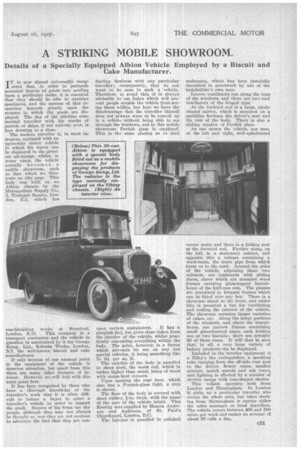A STRIKING MOBILE SHOWROOM.
Page 53

If you've noticed an error in this article please click here to report it so we can fix it.
Details of a Specially Equipped Albion Vehicle Employed by a Biscuit and Cake Manufacturer.
TT is now almost universally recog nized that, in order to persuade potential buyers of goods into settling upon a particular make, it is essential that they should be able to examine specimens, and the success of this inspection depends greatly upon the manner in which the goods are displayed. The day of the old-time corn-, mercial traveller with his stacks of parcels or skips, if not entirely over, is fast drawing to a close.
The modern traveller is, in most instances, equipped with an
up-to-date motor vehicle in which his wares can be displayed to the greatest advantage,whilst, in many cases, the vehicle actually becomes. a mobile showroom, such as that which we illustrate on this page." This body was built on an _Albion chassis by the Metropolitan Supply Co., 3, Tredegar Square, London, E.3, which has
coaebbuilding works at Stratford, London, E.15. This company is a transport contractor and the vehicle in question is maintained by it for George Kemp, Ltd., Kelceda Works, London, N.7, the well-known biscuit and Cake manufacturer.
. If only because of one unusual point in the equipment of the vehicle it deserves attention, but apart from this there are many other features of interest. However; we-will deal with this Main point first. •
It has been recognized by those who have a thorough knowledge of the traveller's work that it is often difE, cult to induce a buyer to enter a traveller's vehicle in order to inspect the stock. Buyers of big firms are shy people, although they may not always be thought so. mid they are not anxious to advertise the fact that they are con ducting business with any particular traveller ; consequently, they do not want to be seen in such a vehicle. Therefore, to avoid this, it is always advisable to use lights which will prevent people outside the vehicle from seeing those within, but here we have the disadvantage that the traveller himself does. not always want to be coop,3d up in a vehicle without being able to see through the windows, and in this mobile showroom Purdah glass is employed. This is the same glazing as is used
upon certain ambulances. It has a purplish tint, but gives clear vision front the interior of the vehicle, whilst practically concealing everything within the body. The price, however, is a factor which prevents its use on any but special vehicles, it being something like 7s. (Id. per sq. ft.
The exterior of the body is panelled in sheet steel, the waist rail, which is rather higher than usual, being of wood with steam-bent corners.
Upon opening the rear door, which also has a Purdah-glass light, a step is shown. • The floor of the body is covered with sheet rubber, 4-in. thick, with the name of the user of the vehicle inlaid. This flooring was supplied by Messrs. Anderson and Anderson, of St. Paul's Churchyard, London, E.G. The interior is panelled in polished mahogany, which has been tastefully decorated in paintwork by one of the bodybuilder's own men.
Louvre ventilators run along the tops of the windows, and there are two roof ventilators of the hinged tYPe.
At the forward end is a large, nicely shaped mirror, which is mounted on a partition between the driver's seat and the rest of the body. There is also a sliding window of Purdah glass.
As one enters the vehicle, one sees, at the left and right, well-upholstered
corner seats, and there is a folding seat at the forward end. Farther along, on the left, is a stationary cabinet, and opposite this a cabinet containing a wash-basin, the drain pipe from which leads on to the road. Around the sides of the vehicle, adjoining these two cabinets, are cupboards with sliding doors, above which are mounted wood frames carrying glass-topped biscuitboxes of the half-case size. The glasses are contained in bronzed frames which can be fitted over any box. There is a showcase stand at the front, and under this is mounted a fan for ventilating and cooling the interior of the vehicle. The showcase contains larger varieties of cakes, etc. Along the lower portions of the windows, and above the biscuitboxes, are narrow frames containing small glass-fronted cases, each holding one or two biscuits; there are actually 26 of these cases. It will thus be seen that, in all, a very large variety of bakery products can be displayed.
Included in the interior equipment is a Riley's fire extinguisher, a speaking tube running from the off-side rear seat to the driver, flower vases, smaller mirrors, match stands and ash trays, and lighting is effected by a number of electric lamps with rose-shaped shades.
This vehicle operates both -from London and Birmingham. In London it picks up a particular traveller who covers the whole area, but when working from Birmingham it carries either the sales manager or local travellers. The vehicle covers between 400 and 500 miles per week and makes an average of about 20 calls a day.












































































































